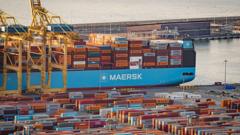As tariffs imposed by former President Trump take their toll on the Burgundy wine industry, winemakers express fears over potential price hikes and reduced exports to the U.S., while American wineries also voice concerns about the collateral damage to their industry.
Tariffs Sour Relationship Between U.S. and French Winemakers Amid Trade Tensions

Tariffs Sour Relationship Between U.S. and French Winemakers Amid Trade Tensions
Donald Trump's tariffs threaten to disrupt the thriving Burgundy wine export market, leaving winemakers concerned about future sales and trade relations.
Burgundy, France's legendary wine region, is grappling with the consequences of Donald Trump's aggressive trade policy, particularly since the U.S. is its largest export market. The region, celebrated for its exquisite wines, now faces potential pricing challenges due to steep tariffs implemented under Trump's administration.
On a chilly Spring day in Morey-Saint-Denis, vineyard worker Élodie Bonet meticulously prunes vine shoots, ensuring the healthiest grapes for the prized wine that will soon be produced. At the winery owned by Cécile Tremblay, where oak barrels age red wines with illustrious names like Nuits-Saint-Georges and Clos-Vougeot, the atmosphere is mixed with excitement and anxiety. Tremblay notes that the U.S. accounts for roughly 10% of her production, a significant part of her sales.
Since April 5, Trump's administration has altered import tariffs multiple times, initially proposing a staggering 200% mark-up on European alcohol before settling on a 10% tax. However, future increases up to 50% loom, casting shadows over the prospects of Burgundian winemakers. Tremblay, reluctant to elaborate on the worries, reflects a sentiment of fear lingering across the industry.
François Labet, president of the Burgundy Wine Board, stresses the importance of the U.S. market, which remains the largest in volume and value for the region. Despite French wine exports slipping 4% last year, sales of Burgundy wines surged by 16% to 20.9 million bottles worth approximately €370 million. Labet expresses hopes while acknowledging past troubles stemming from Trump's earlier 25% tariffs during a trade dispute that severely impacted sales.
Burgundy wines are primarily known for their pinot noir reds and increasingly popular white wines made from chardonnay. With the general decline in red wine consumption globally, these nuanced, lighter reds are increasingly favored among American consumers. Yet, the looming threat of tariffs dampens prospects for continued growth.
Labet recalls a similar tumultuous period during Trump's earlier presidency when the U.S. tariffs nearly halved Burgundy's exports. Current expectations are that wine producers and U.S. merchants might share the new import costs, but a further increase would dangerously halt trade momentum, returning the industry to its 2019 struggles. Jerome Bauer, president of the French National Wines and Spirits Confederation, documents loss estimates amounting to $600 million during previous tariff phases.
The call for free trade has become a rallying point for many in the wine sector. Interestingly, American vintners, such as Rex Stoltz with Napa Valley Vintners, lament the potential tariffs too. He highlights how wine production relies on international sourcing for materials, positioning the industry as interconnected. Stoltz illustrates the consequences trade wars pose, noting that Canadian markets have halted imports of American wines entirely.
In this interconnected global economy, both French and American winemakers are caught in a precarious situation—hoping to preserve the essence of collaboration and trade amidst a landscape shaped by tariffs and negotiations.






















